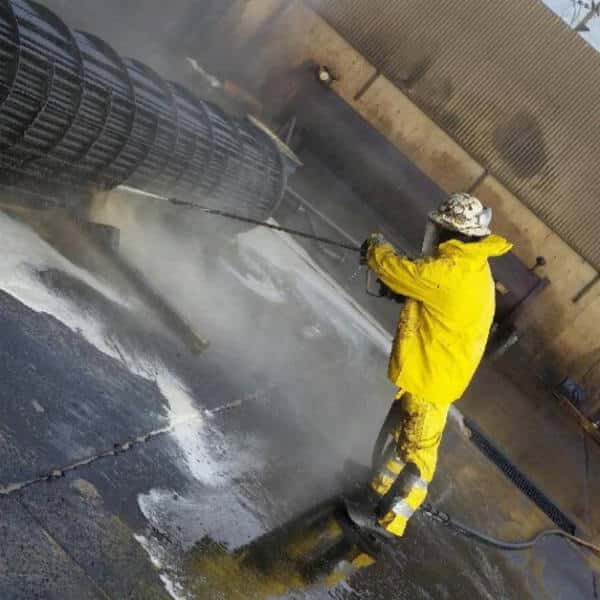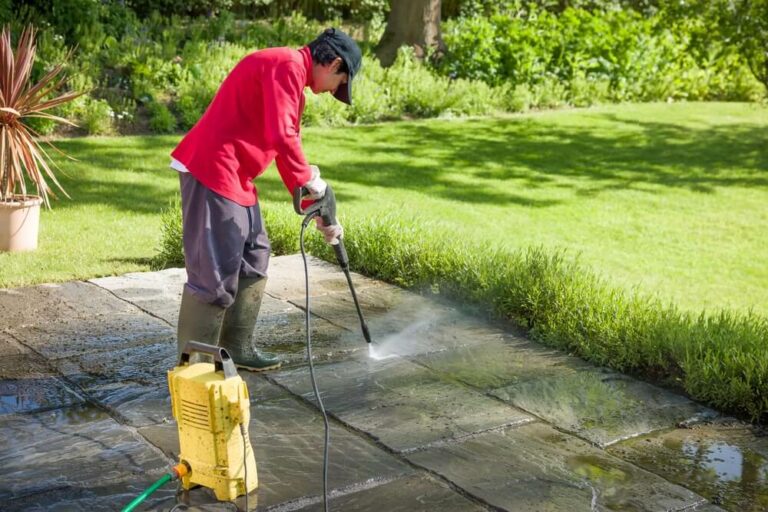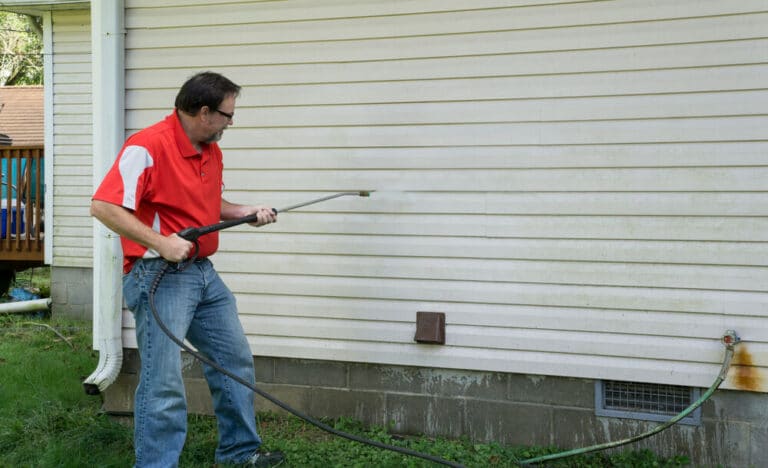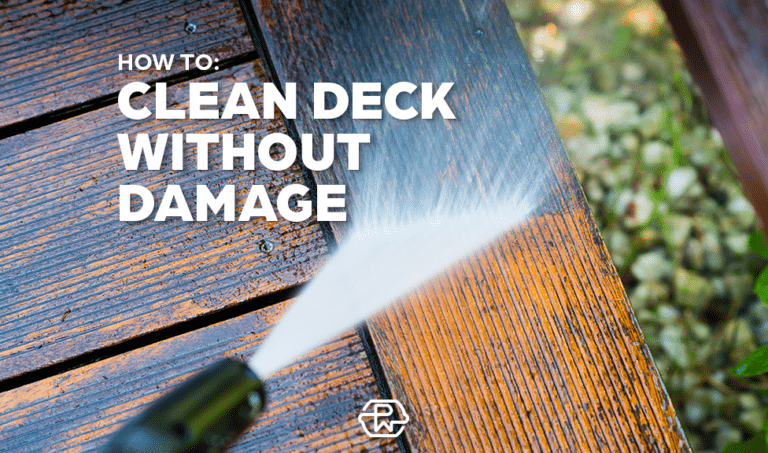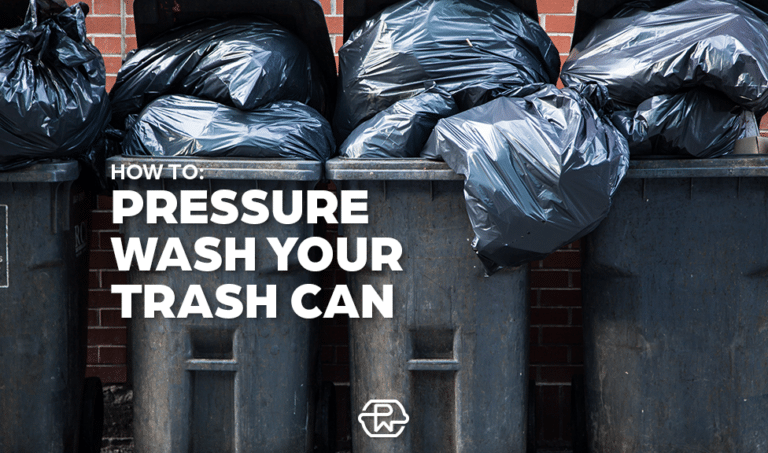Pressure Washer Safety Tips For Beginners
Operate the best pressure washer safely or risk serious to catastrophic injury.
Seriously, pressure washer safety is no joke. Have you seen the injuries a power washer’s jet spray can cause?
The sad thing is most pressure washer injuries are 100% avoidable. Don’t be stupid. Just because you are around the house doesn’t mean you should wear flip flops and treat the pressure washer like a super soaker.
Pressure Washer Safety Checklist
Here’s a summary of the 7 pressure washer safety tips:
Now let’s take a look at each in detail:
Pressure Washing Safety Tip #1 – Assessing the Work Place
Take 5 minutes before the job to think through the task, identify the hazards and how to decrease the risks. During this 5 minutes walk around the area where you will be cleaning and ask yourself these questions:
- Do I feel ready and up to the task today? Did you lift weights at the gym yesterday and feel particularly weak. Did you have a late night and feel drowsy.
- Is the weather today good for pressure washing? Power washing in the rain or heavy wind is not the safest.
- Is the area clear of hazards? When you’re focusing on the job toys, bikes, pets and even trees can come out of nowhere.
- Am I spraying near electrical, open windows or house vents? Be sure to wrap electrical in plastic, close windows and cover vents to prevent damage from the water spraying.
- Do I know what to do if the pressure washer starts making weird noises, pops a leak or starts smoking? Be sure to have a clear method in your mind what to do if the unthinkable happens.
- Am I adequately protecting myself? Be sure to wear the proper personal protective gear.
- How can I get hurt? Write down all the ways you can get hurt pressure washing today. Everything from tripping to falling down stairs and a car running you over.
- What can I do to prevent getting hurt? Look at the hazards you came up with and think of controls to prevent them from happening. For example, if you need to pressure wash your driveway and need to have your body in the street to get the end curb – have your friend, wife, neighbour or someone spot you and watch for cars for you.
Why is this tip important?
You can’t avoid a hazard if you don’t know it’s there.
Safety Tip #2 – Wear appropriate personal protective equipment (PPE).
It’s simply ridiculous how many injuries can be prevented with proper PPE. Just because there are no enforced rules at home doesn’t mean you shouldn’t wear steel toe boots and other equipment.
Here’s what’s recommended:
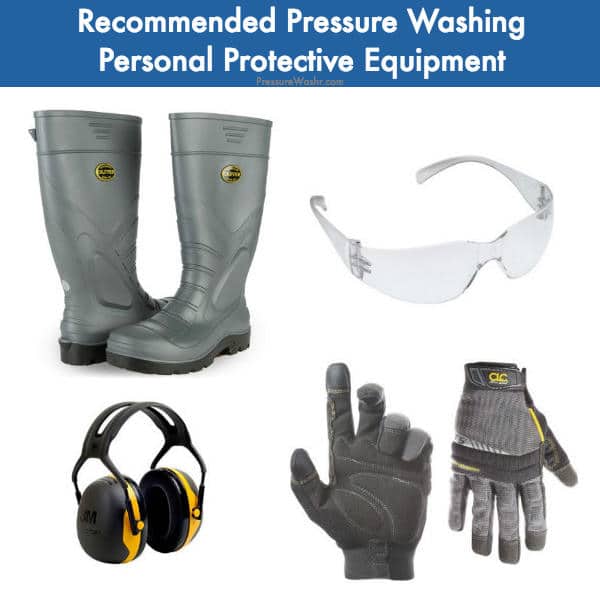
- Safety glasses or goggles. Such a no brainer. Proper safety glasses will prevent flying projectiles entering your eye. And when dealing with high pressure water spraying dirt and debris off surfaces this is simple risk reduction that you need to do.
- Enclosed shoes. Another easy implementation. At best you want to be wearing proper steel toe gumboots or work boots. At worst wear enclosed running shoes.
- Gloves. The most common point of injection injuries is the hand. Wear proper safety gloves.
- Ear protection. Especially needed if you plan on using a gas powered pressure washer for extended duration. Not necessary with electric pressure cleaners.
- Pants. There is going to be debris flying everywhere. Wear pants to protect your legs even if it is hot outside.
Why is this tip important?
Your feet, hands, and eyes are easy to protect and are at high risk of being injured by flying debris
Safety Tip #3 – Read the User Manual
Read the User Manual front to back before operating the pressure washer. Each pressure washer is slightly different. There are not only gas and electric types but belt drive, direct drive, hot water and cold water.
Your User Manual will explain everything you need to know about operating your machine and will give you troubleshooting tips and machine specific safety tips.
Read it. They are 15 pages long and won’t take longer than a cup of coffee to finish reading.
Why is this tip important?
Each machine is different and you need to know the right way to use it.
Safety Tip #4 – Never use a gas pressure washer in an enclosed space.
There are two reasons to not use a gas power washer in enclosed structures:
- Poisonous exhaust fumes. Your gas power washer engine emits carbon monoxide, which can cause all sorts of problems if you breathe it in in excess: nausea, dizziness and headache. To avoid the issue make sure you pressure wash only in well ventilated areas.
- Louder noise. A petrol pressure cleaner uses a similar small engine as a lawn mower and is as loud. It will be even louder in an enclosed space due to the sound being amplified by the small space. Wear ear protection to avoid hearing loss or damage.
Why is this tip important?
Combustion engines exhaust a poisonous gas called carbon monoxide that you don’t want to breathe in.
Safety Tip #5 – While cleaning be aware of your surroundings.
Be aware of playing children, pets, passing cars, slippery surfaces, electrical wires and power lines.
You should know about these risks from your 5 minute pre job analysis (Pressure Washer Safety Tip #1) but things change and new hazards can be introduced.
Why is this tip important?
Trip hazards, playing kids, and moving vehicles are risks to be avoided.
Safety Tip #6 – Start washing with the widest angle spray tip
Start washing with the widest angle spray tip 2-feet from a test surface and adjust nozzle and distance as needed. Pressure washers come out-of-the-box with 4-5 different types of spray nozzles:
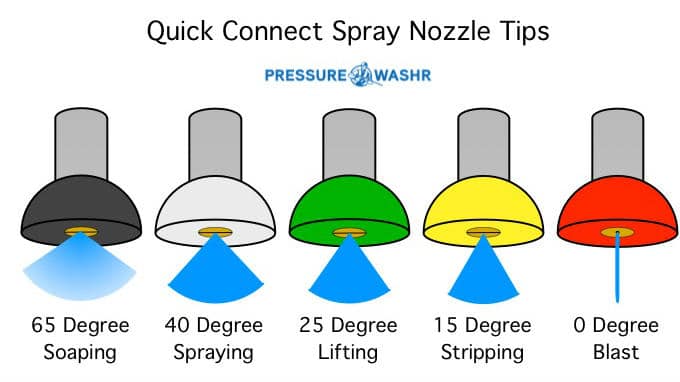
- Red tip: 0-degree pinpoint jet.
- Yellow tip: 15-degree medium jet spray.
- Green tip: 25-degree general cleaning and lifting.
- White tip: 40-degree gentle fan spray.
- Black tip: Soaping tip wider oriface and 65-degree mist spray.
You shouldn’t ever need to use the red tip nozzle and will rarely need the yellow tip. The green tip is the most used.
To not damage the surface start off your pressure washing with the white tip attached and start spraying a test surface holding the spray a few feet from the surface. If it cleans then all good. If not, start moving the spray a little closer. Never go closer than 6 inches. If you get to 6 inches and the force isn’t enough to properly clean the surface. Repeat the process with the green tip.
Why is this tip important?
High pressure injection injuries are not to be underestimated.
Safety Tip #7 – Avoid ladders and working at height.
Nothing is more dangerous than working at height when pressure washing. Why create a hazard? A fall from 3-feet can be fatal if you fall the wrong way and hit your head. Use an extension wand and keep your feet planted firmly on the ground.
Why is this tip important?
The kickback can push you off the ladder. Why risk it when there are extension wands?
Real Life Experience of Pressure Washing Injury
High pressure injection injuries should not be underestimated – here’s my first hand experience:
A few years back a long time co-worker of mine was rushed to hospital.
He was lucky.
His spotter acted fast because he knew the severity of the injury.
Here’s what happened:
He lost balance when using a high pressure grease gun, moved his hand into harms way to gain balance and injected grease at high pressure through the safety gloves and into his hand’s index finger near where it meets the palm.
Because he received near immediate treatment at the emergency room he was able to keep his index finger, although some of its function was lost.
It doesn’t matter if the fluid is water, grease or paint – all can cause permanent damage and even amputation when injected at high pressure.
A pressure washer may not have the same high pressure as a grease or paint gun but the PSI is enough to cause serious harm.
Let’s look in detail why you need to be careful and the 7 pressure washer safety tips to stay safe.
Why You Need To Be Careful When Operating a Pressure Washer
Because check out the damage the jet spray can do to you:
Pressure washer injury #1
This guy felt a bug on his leg and used the pressure washer spray to get rid of it. As you can see he badly lacerated his leg at the shin. It could have been much worse.
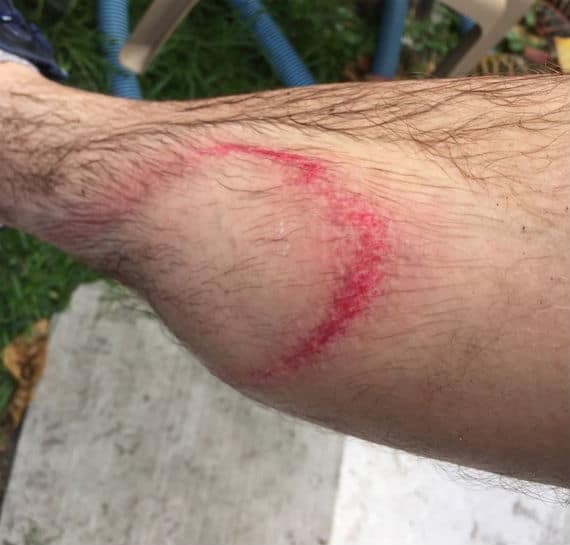
His injury had to be checked out at the emergency room because high pressure water injection is very dangerous.
Luckily the damage was only to the surface and he was prescribed antibiotics and sent on his way.
High pressure injection injury from pressure washing #2
This is one of the more serious examples why you must treat power washers with respect.
In this example, the women decided to wash dirt off her hand with the high pressure spray and by accident turned the pressure up when doing so causing the lacerations.
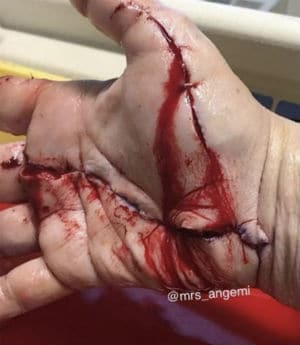
At the hospital surgeons made further cuts up the hand trying to clean out the dirt. (h/t: @mrs_angemi)
Bloody big toe power washing injury #3
Check out all that blood. This guy thought it would be a good idea to pressure clean barefoot and then clean his feet off with the water spray. Not the best idea…
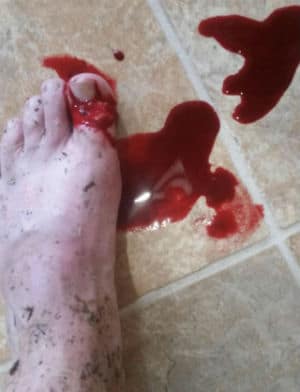
…Humans are rubber meat bags, essentially. And a water jet spray can cut through your outer skin layer at around 1,160 PSI.
Most residential pressure washers are thus capable of causing serious injury so be sure to be smart and wear proper protective equipment.
Because the kickback force can be tremendous and cause you to fall backward off a ladder, or into traffic…
I’ll never forget when I was working at a rendering plant and tasked with cleaning walls of one of the receiving bins.
The Foreman had rented a 4,000 PSI commercial electric powered pressure washer for me to use. The kickback when I turned it on was surprising and enormous. The floor was slippery and it pushed me back a few inches.
And this guy is using a 10,000 PSI machine. Take a look. The kickback is exerting such a force that he needs to counteract it by leaning forward nearly 45-degrees.
Because check out the damage different PSI pressure washers can do to different surface materials:
Did you know there are water jet cutters that pierce through cold rolled stainless steel with ease?
There are water jet cutters upwards of 90,000 PSI but you don’t need that much PSI to do serious damage to surfaces around your home.
Pressure washers generate enough force to damage concrete, wood and your skin.
Just what amount of PSI is required to punch a 0.1 inch deep (2-3 credit cards thickness) 1 inch squared (stamp size) hole in these different materials?
| Material to be Cut | Ultimate Strength (PSI) | PSI (Force) to Cut Through 1″ Square hole 0.1″ Thick |
|---|---|---|
| Graphene | 18,854,901 | 7,541,960 |
| Diamond | 406,106 | 162,442 |
| Tungsten | 219,007 | 87,603 |
| Structural Steel | 72,519 | 29,008 |
| Bamboo | 60,191 | 24,076 |
| Bone | 18,855 | 7,542 |
| Nylon | 10,878 | 4,351 |
| Wood, pine | 5,802 | 2,321 |
| Glass | 4,786 | 1,914 |
| Concrete | 4,351 | 1,740 |
| Human Skin | 2,901 | 1,160 |
| Rubber | 2,321 | 928 |
Cutting PSI is a function of ultimate strength and area of cutting surface and thickness of material to be cut through.
Force (pounds) of Pressure Washer = Ultimate strength of material (PSI) x Cutting area perimeter (inches) x material thickness (inches)
An assumption is that you’re holding the pressure washer with a 0-degree nozzle close enough to the surface that it hits it within a 1″ squared area (a little bigger area than your thumb nail).
A material thickness of 0.1″ (2-3 credit cards thick) is used in the calculation. For something like your wood deck, the 2,321 PSI pressure washer will only slightly damage the surface because your deck panels are more than 0.1″ thick.
To calculate these numbers the materials’ ultimate strength was multiplied by the 0.1″ material thickness and the perimeter of the area it makes on the surface (1″ squared has a 4″ perimeter). This outputs the force in pounds. PSI is pounds per square inch and we are shooting a 1″ squared area so this is the PSI pressure washer required to punch the hole.
Wrap Up
Don’t be stupid and risk injuring yourself or damaging the surface you’re cleaning.
These 7 simple but effective safety tips should keep you out of harms way. There is just no need to put yourself at risk on a Sunday while pressure washing your house siding.
Safety first.

